Fig. 4.1
(a) A single optic fiber, maintained in a still position, destroys only a small amount of tissue, e.g., 16–18 mm in length, 8–10 mm in width, and 8–10 mm in thickness, i.e., about 1 ml volume (delivered energy 1600–1800 J, output power: 2–4 W). (b) More fibers in line configuration may obtain a larger ellipsoid nodule ablation. Cartoon of a transverse scan, showing needles inserted one at a side of the other at a distance of 10 mm in order to match ellipsoid nodule shape. With up to four parallel fibers, a coagulation zone up to 40–45 mm wide and 22–26 mm thick may be obtained. (c) Ultrasound transverse scan of a thyroid nodule ablated with four parallel optic fibers. The four laser marks are clearly visible as well as the ablation zone
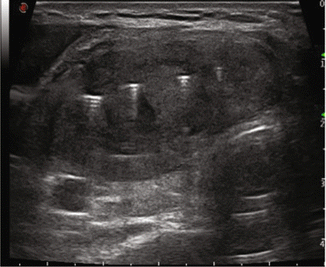
Fig. 4.2
B-mode imaging, transverse scan of thyroid nodule during laser ablation. Heat delivered during laser firing is visible as illumination of four needles at the same time
RFA has been introduced in the treatment of thyroid nodules more recently [5, 6]. This technique uses high-frequency radio waves that heat the tissue by ionic friction (Fig. 4.3). Data on its effectiveness are increasing (Figs. 4.4, 4.5, and 4.6).
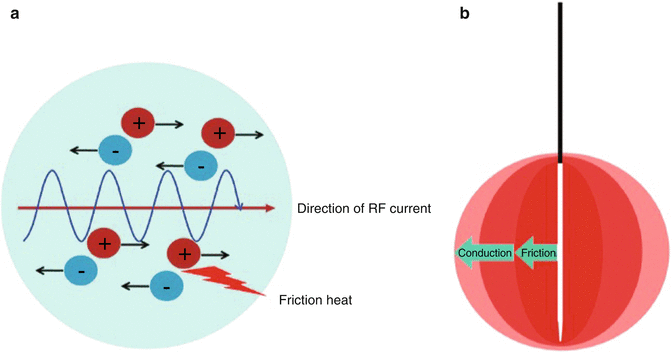
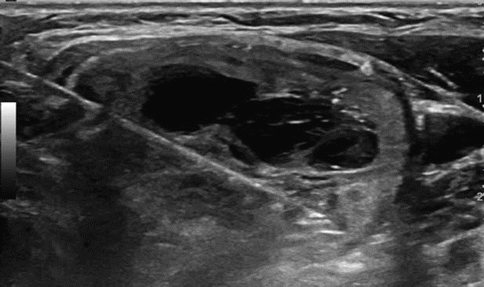
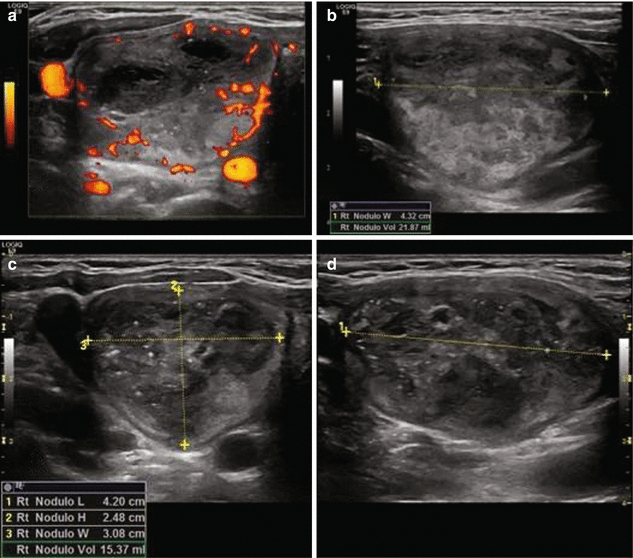
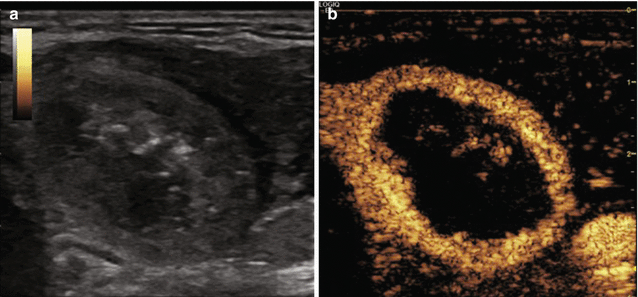





Fig. 4.3
(a) Ionic agitation and formation of frictional heat. Tissue ions are agitated by application of alternating electric current. Ionic agitation results in ion friction, which causes heat production. (b) Heat propagation through target tumor. Immediate tissue coagulation necrosis is achieved by frictional heat generated in vicinity of electrode, but electrode-remote tumor tissue is ablated more slowly, via conductive heat. Radiofrequency (RF) (Modified by reference [5])

Fig. 4.4
Transverse ultrasound image of the moving-shot radiofrequency ablation technique. The electrode needle is inserted toward the common carotid artery

Fig. 4.5
Transverse (a) and longitudinal (b) ultrasound images of a thyroid nodule before radiofrequency ablation. Transverse (c) and longitudinal (d) ultrasound images of the same thyroid nodule one month after radiofrequency ablation. Note volume reduction from 21.87 to 15.37 ml (volume reduction of about 30 %)

Fig. 4.6
Transverse B-mode (a) and CEUS study (b) of a thyroid nodule treated with radiofrequency. CEUS demonstrates large ablation of the nodule with minimal residual viable tissue left vital
< div class='tao-gold-member'>
Only gold members can continue reading. Log In or Register to continue
Stay updated, free articles. Join our Telegram channel

Full access? Get Clinical Tree


